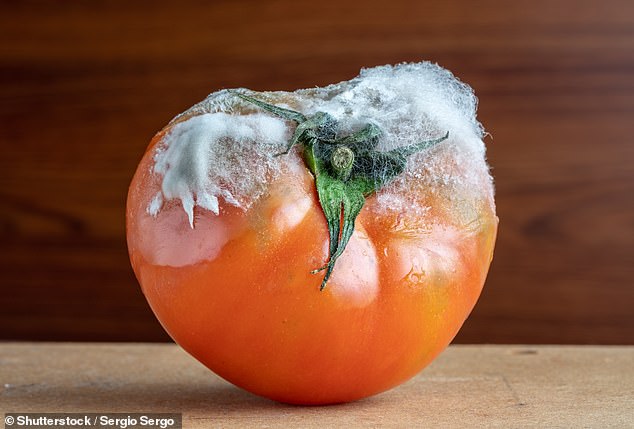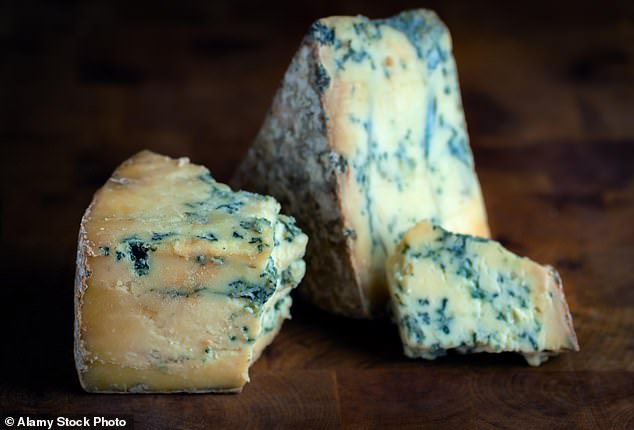I'm a food safety expert and here's what you can still eat, even if it's moldy
It can be disappointing when your fresh bread (well, at least you thought so) is covered in green mold.
But did you know that scraping off the moldy spots and stuffing them in some foods can be harmless?
Just don't try it with bread…
So says food safety specialist Dr Richard Fuchs from the University of Greenwich, who tells MailOnline what food you can still eat, even if it's moldy, and what should go straight into the bin.
Because bread is porous, mold structures can grow through it and not just on the surface
Food that is clearly rotting or contains mold should not be eaten, according to the Food Standards Agency (FSA).
This advice is especially important for people in vulnerable groups, such as children, pregnant people, people over 65 and anyone with a weakened immune system.
Consuming mold – technically just a microscopic mold – can make us sick.
Avoid moldy grains, nuts and apples
Nuts, grains and apples can be among the most dangerous foods to eat, at least if you find a patch of mold on them, says Dr. Fuchs.
He said: 'Consumers may be allergic to the molds or develop respiratory diseases if exposed to them.
'Second, molds can produce toxic compounds called mycotoxins.'
Mycotoxins, described as 'extremely dangerous', can suppress the immune system and cause reproductive problems.
Some have even been linked to cancer.
“They will rarely have acute effects, but with long-term exposure they will,” said Dr. Fuchs.

Soft fruit and vegetables, such as tomatoes (photo), are less resistant to mold than harder fruit or vegetables, such as carrots
However, aflatoxin, the most harmful type of mycotoxin, is known to cause these serious complications.
It is produced by two types of fungi – Aspergillus flavus and Aspergillus parasiticus – and can be found in moldy nuts, rice, spices, vegetable oils and cocoa beans.
In large doses, aflatoxins can be life-threatening.
Patulin is another mycotoxin that can grow on rotting apples. If eaten, it can cause “nausea, gastrointestinal disturbances and vomiting,” according to the World Health Organization.
Avoid moldy soft cheese, berries and bread
Although not all molds are so dangerous, eating them can still make you feel unwell.
To make matters even trickier, the mold you can see on the surface of food isn't the full extent of the problem, Dr. Fuchs warns.
At this point, mold spores have already penetrated deeply into the product.
“Fungi produce microscopic thread-like structures called hyphae that can spread into food,” he said.
'It is therefore possible that what is visible on the surface is not the full extent of the contamination by the fungus.'
The softer the food, the easier it is for mold to penetrate the surface.

By removing the mold from a block of hard cheese and leaving an inch around it, you can eat it safely. Blue cheese (pictured) is made with mold that is safe to eat
For example, foods with a high water content, such as juicy berries, jam or even soft cheese, cause the mold to spread more deeply.
Bread is another culprit; its porous structure allows hyphae to grow within it.
This means that if you find a small spot of mold, it is probably in the entire jar of jam or container of fruit, even if it is only visible on the surface.
But some cheeses ARE safe
One of the few foods you can eat even if it is moldy is hard cheese.
“Hard, dense foods such as hard cheeses or firm fruits and vegetables are more resistant to mold penetration, so the mold can be cut out and the food consumed,” he added.
To be on the safe side, Dr. Fuchs recommends that people cut off about an inch of food around and below the moldy area.
However, when mold is used specifically to make a product, such as blue cheese, it is safe to eat.
